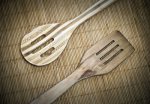A commonsense guide to toxic plastics in your home, and how to avoid them.

Toxic plastics, used in many kitchen and household items, contain a variety of dangerous chemicals.
Three of the most toxic chemicals are bisphenol-A (BPA), PVC and Phthalates.
BPA, PVC and Phthalates can be found in plastic food packaging, plastic food storage containers, plastic water bottles, canned foods, toys, cooking implements and even kitchen appliances like coffee makers.
The problem is that when we use plastics in our kitchens, these chemicals migrate out of the plastic and into the food and drink we consume.
All three chemicals are extremely dangerous to our health – and most dangerous of all to unborn babies, infants and children.
Why are they so dangerous? They are all what are known as endocrine disruptors. They can upset normal hormonal balance in our bodies, stimulate the growth and development of cancers (breast, uterine, prostate), impair fertility, and disrupt pregnancy.
There are other sicknesses associated with these chemicals, including heart disease and behavioral problems in children.
And they are all over your house, not just in your kitchen.
They may be in the plastic of the bottle containing the organic shampoo you bought last week, or in the plastic used to make the toy duck your child is chewing on right now.
Is this threat real?
Good question.
It is real enough for all the countries in the European Union to place a ban on the use of endocrine disruptors in plastics that come into contact with food and drink. And the same goes for plastics that are used in baby bottles, sippers and toys that might be chewed by young infants.
It is real enough for the Government of Canada to ban the use of BPA in baby bottles.
It is real enough for the State of Minnesota to ban the use of BPA in baby bottles.
In the Western World, the only federal government that insists these plastics are safe is the US Government. Interestingly, several US plastics manufacturers are voluntarily removing these chemicals from many of their products, and a number of retailers are removing toxic plastics from their stores. But the EPA has no bans or prohibitions in place for any of these chemicals.
As a result, if you live in the US, or eat packaged foods imported from the US, you are likely feeding these endocrine disruptors to your family.
How can you protect yourself and your family from these chemicals?
1. Educate yourself. Learn about the different plastics in your home. Identify them by the recycling number you will find on most plastic products.
2. Throw out all plastics which contain bisphenol-A (BPA), PVC or Phthalates.
3. Replace those plastic items with alternatives -- like items made from safe plastics, glass, steel, ceramics or wood.
Further reading:
Recent Updates
-
Why the American Chemistry Council sponsored the 5th International Marine Debris Conference in Honolulu, Hawaii.
Apr 26, 18 09:58 AM
I have written before about the American Chemistry Council, and how hard it works to defend the ongoing production of all plastics, regardless of the environmental -
BPA-free food processors and blenders.
Dec 28, 16 10:21 PM
If you are looking for a BPA-free food processor or blender, you have a few choices. -
Alternatives to plastics in your kitchen – glass, wood, stainless steel and cera
Dec 28, 16 09:49 PM
To keep your kitchen food-safe, BPA-free, phthalates-free and PVC-free, switch to traditional alternatives like glass, stainless steel, wood and ceramics. -
Toxic plastics contain dangerous chemicals like bisphenol-A, phthalates and PVC
Dec 28, 16 09:44 PM
Plastic food packaging and food storage containers containing bisphenol-A, phthalates and PVC are toxic, and bad plastics to use in your kitchen.









